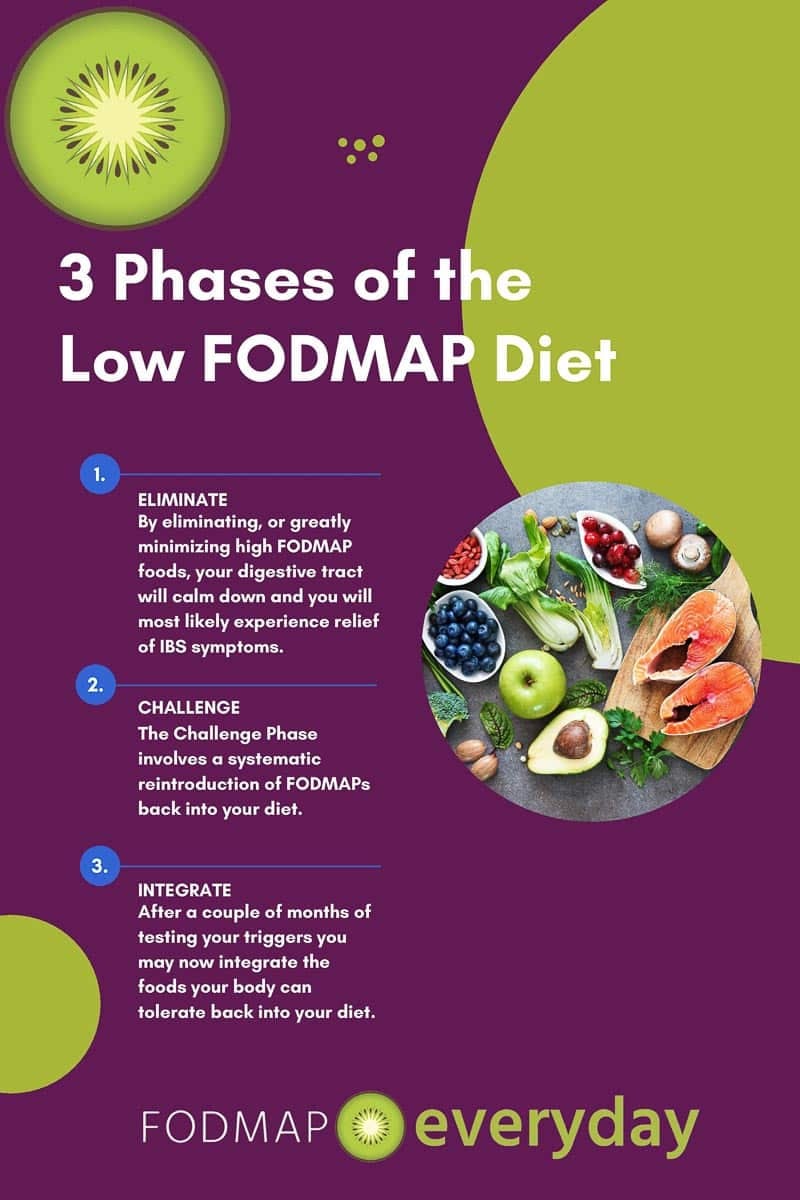Introduction To The Low FODMAP Diet
At FODMAP Everyday® we educate about the 3-phase low FODMAP diet, as developed and described by Monash University. The phases are The Elimination Phase, The Challenge Phase and The Integration Phase.
Our mantra is: Eliminate, Challenge, Integrate!

First Learn About FODMAPs
To understand the diet, you do have to become familiar with what FODMAPs are. FODMAP is an acronym that stands for Fermentable Oligosaccharides, Disaccharides, Monosaccharides and Polyols (like mannitol and sorbitol, xylitol and maltitol, which are sugar alcohols). Please do read our article What Are FODMAPs? for a deeper-dive.
In brief, FODMAPs are for a group of short-chain carbohydrates that are indigestible or poorly absorbed by certain people.
FODMAPs are found in vegetables, like peas, spinach, mushrooms, eggplant, avocados, zucchini, tomatoes, cauliflower, broccoli, artichokes, Brussels sprouts, green beans, pumpkin and more. In fruit, like apples, apricots, watermelon, blackberries, pineapple, bananas, pears, mangoes, peaches, coconut, cherries, blueberries, plums, nectarines and others. In grains and beans and foods based upon them, like rye, barley, chickpeas, lentils, other legumes, oats and tofu. In nuts like almonds, and sweeteners like honey and high fructose corn syrup.
But don’t fret, the initial, most restrictive Elimination Phase (more below) is short and there are plenty of vegetables, fruits, grains and more that you can enjoy in low FODMAP amounts, even during this stringent phase. Many of the items listed in the last paragraph DO have a small low FODMAP serving size, and then others have generous servings like kale, cucumbers, carrots, lettuce, and potatoes; oranges, strawberries, grapes, and kiwi; brown rice and quinoa and even low FODMAP pasta. Even eggs and butter are low FODMAP!
Learn About The Low FODMAP Diet
The three phases of the diet help you learn what your food triggers are and how to bring them back into your diet, for optimal gut health and to keep GI symptoms at bay. You will be pain-free and eating very well!
In fact, the goal of the low FODMAP diet is to have you eating as broadly as possible, as nutritionally broad as possible, with the right amount of fiber, prebiotics, probiotics and general good nutrition – without triggering your GI symptoms.
In fact, the goal of the low FODMAP diet is to have you eating as broadly as possible, as nutritionally broad as possible, with the right amount of fiber, prebiotics, probiotics and general good nutrition – without triggering your GI symptoms.
The low FODMAP diet is nuanced and complex and it is recommended that it be undertaken along with a FODMAP knowledgable Registered Dietitian (RD), preferably Monash University trained.
The way you conduct the diet will be unique to you and your medical needs, which can be determined along with your RD. There are certain over-arching approaches, but it will end up being unique to each and every one of you.
Some high points:
- The diet is primarily recommended by gastroenterologists for those who have been diagnosed with IBS, after a careful screening for diseases and issues like celiac disease, diverticulitis, endometriosis and others whose symptoms can mimic IBS. Do not self diagnose or begin the diet on your own without a medical doctor’s recommendation.
- The diet focuses on carbohydrates, because pure fats (like olive oil and other oils) and proteins (like beef, chicken, and fish) do not contain FODMAPs.
- The diet may also be suggested for those diagnosed with SIBO (small intestinal bacterial overgrowth), IBD (inflammatory bowel disease), Crohn’s disease and certain other medical diagnoses.
- The low FODMAP diet is not gluten-free, nor is it wheat-free.
- It is not a weight loss diet.
- It can help those with both IBS-C (constipation), IBS-D (diarrhea), IBS-M (mixed) as well as those experiencing abdominal pain and/or distension, and general IBS symptoms.

ELIMINATE
The Elimination Phase is what you might have heard about – and what maybe confused you and/or scared you. When someone says “low FODMAP diet”, they are often talking about this phase, when in fact the low FODMAP diet is a system.
If you have been diagnosed with IBS we encourage you to work with your gastroenterologist and/or registered dietitian if undertaking the low FODMAP diet. You just might be one of the 75% of IBS sufferers who experience complete symptom relief.
There is no getting around the fact that this first Elimination Phase is restrictive – it is called an Elimination diet, after all – but this segment of the diet is only to be followed for a period of 2 to 6 weeks, so don’t worry! (Your RD can help determine the time frame that is best for you). By eliminating high FODMAP foods your digestive track will calm down and you will very likely experience immediate relief.
Certain high FODMAP foods will be eliminated during this brief time, such as garlic, onions – and wheat to a certain degree. All of these contain fructans, which are statistically the most problematic FODMAP for most people (they are part of the Oligosaccharides).
You may want to read our articles: IBS: Step-by-Step Guide from Diagnosis to Symptom Free Living and The Low FODMAP Diet Elimination Phase: Short & Sweet for Your Health!
Typically within one week you will know if the diet is working for you – and for many people, you might know within a few days! After experiencing so much pain and debilitating symptoms, oftentimes for years, we are betting that giving up some foods for a very brief period of time will feel like a reasonable trade-off.
Your RD can also help you navigate the sometimes complicated path of determining whether you have any concurrent medical issues, such as SIBO or true food allergies.
CHALLENGE
The Challenge Phase (also called the Reintroduction Phase by Monash) involves a systematic reintroduction of FODMAPs back into your diet. Remember, FODMAPs are various small carbohydrates, which you can refresh yourself about in What Are FODMAPs?
Challenge & Re-Introduction
You might see this phase referred to as “re-introduction”. The reason we call it the Challenge Phase is because that is exactly what you will be doing: Challenging yourself with foods, one at a time, to assess your individual tolerance. You will learn what triggers symptoms for YOU, as different foods trigger symptoms in each of us uniquely.
If you fail with a food, RDs will oftentimes suggest that you try that food again at a later date, maybe 6 months down the road or so. This is what we call “re-introduction”, because you are re-introducing, not challenging for the first time.
Your dietitian will help you add individual foods back into your diet, one food at a time and one category at a time. You will document your digestive reactions, or lack thereof, and in this way you will learn what your own personal FODMAP roadmap is. The goal is to be able to eat as broadly as possible, without triggering GI symptoms.
This might sound complicated, but it really isn’t. It does take time – the Challenge Phase can last anywhere from 6 weeks to 2 months and is tagged onto the approximately one-month Elimination Phase. The timing will largely depend on whether you already know if you have certain FODMAP issues, such as a lactose intolerance, but you are in control of the Challenges and for so many of us, who have felt like our bodies were controlling us for so long, this alone is empowering.
After Just Two-and-a Half to Three Months, You Could Be Loving Food Again!
Every day during the Challenge Phase you will learn more about what your body can tolerate and what it cannot, and this is information that not even your doctor can tell you! And most likely by this time in the diet you will be pain-free and symptom-free and amazed at how far you have come and in such a short period of time.
At the end of The Challenge Phase you will know your triggers. And this means more than just which foods might cause a reaction. It means you will understand amounts as well, and this is really important. In many ways the low FODMAP diet is as much about portion size as it is about food choices.
You may want to read: What Is A Low FODMAP Serving Size?
For instance, you might learn that a three-scoop ice cream sundae sends your GI system into a tizzy, but that you can tolerate one scoop just fine. This means that the next time your child’s school has an ice cream social or the ice cream truck comes down the block on a hot summer’s day that you will be able to have a treat without repercussions. You will be able to participate in everyday life!
This is why we call ourselves FODMAP Everyday® – because we want you to THRIVE every single day, even while eating with an awareness of FODMAPs. Which leads us to The Integration Phase. Once you finish The Challenge Phase, many FODMAP resources stop there and figure, hey, you are ready to go live your life. But it isn’t so simple. Not until now, anyway!
INTEGRATE
The focus is often on The Elimination and Challenge Phases. In fact, many resources presented the diet as only a two-step approach, which is only part of the story.
After a couple of months of testing your triggers, what follows is actually the most important, impactful and lengthy part of this diet, which is often ignored! We’re talking about the rest of your everyday life.
FODMAPers are often left to their own devices to integrate all this newfound information into their lives. Our team of FODMAP savvy and Monash trained RDs have developed resources for you, so that you can focus on eating really well while remaining IBS symptom-free, and developing healthy gut bacteria.
Please read out article, The Low FODMAP Diet Integration Phase: What To Do After The Challenge Phase.
You may also want to read:
- High FODMAP Foods With Low FODMAP Serving Sizes
- What Is A Low FODMAP Serving Size?
- Ask The Right Question: Is It Low FODMAP or Can I Tolerate This?

Frequently Asked Questions
Here we give you shortcuts to articles that answer the most common questions in regard to the low FODMAP diet.
Researchers at Monash University in Melbourne, Australia developed the diet. The diet is clinically proven to work, which differentiates it from fad diets (like paleo or Whole30). A member of the research team, Sue Shepherd, left Monash and founded FODMAP Friendly. Both Monash University and FODMAP Friendly. are primary, trustworthy resources for the low FODMAP diet.
The low FODMAP diet has 3 stages and it is important to follow each in a structured manner. You can start by reading this article, and you will see that it is strongly recommended that you work with a Registered Dietitian.
The Low FODMAP Diet eliminates and minimizes FODMAPs in your diet. FODMAPs are specific types of carbohydrates that have been clinically proven to trigger IBS symptoms in the great majority of those with IBS.
Everyone wants to know what they can eat on the low FODMAP diet! So many foods ARE included in the low FODMAP diet! Just take a look around FODMAP Everyday® to see in our 1000+ recipes. No entire food groups are eliminated. You CAN eat vegetables, fruits, grains and legumes, dairy and even sweet treats. Please download both the Monash University smartphone app and the FODMAP Friendly app to see all the foods that are included, and what their serving sizes are.
We have a free list (please do not rely on others online as so many are incorrect), but your BEST resource will be the apps mentioned above.
For about 75% of you with IBS, the low FODMAP diet will work very well, which means your GI symptoms will greatly reduce or disappear – even in the first few days. For others it takes longer. The timing will mostly depend on two things: how sensitive you are to FODMAPs, and how well you are following the diet.
There is no cure for IBS. What we can do is manage symptoms – and the low FODMAP diet can be quite successful for many. The best way to get to a pain and symptom-free state is to work with a Registered Dietitian.
Your gastroenterologist might suggest the low FODMAP diet to help with SIBO symptoms. This is not the same as a cure.
It depends! If you get to the Integration Phase and you have established that the diet is working for you (meaning that FODMAPs are a GI trigger for you) then you can be on that last phase for an extended period of time. If the diet is not working for you, there is no need to continue. Please have your dietitian guide your progress.
For about 25% of you with IBS, the low FODMAP diet might not provide relief. We have an entire article for you about how to proceed if this is the case.
The FODMAP Everyday® Difference
This is a scientifically based diet, but we are also concerned about and interested in a true appreciation and love of food. We all eat numerous meals everyday. What happens when only one or two people in a household are following the low FODMAP diet? We make food at home; we pack lunches for school and work. We throw parties and still want to host Thanksgiving dinner! Once someone has gone through a couple of months of working with a dietitian and charting their reactions to eliminating and reintroducing foods, what happens next? How do you Integrate your low FODMAP needs into your life?
That’s why we created FODMAP Everyday®. So that you can eat and eat well, all while integrating the information you have now gathered that is unique to you. Read more in-depth About FODMAP Everyday to get the most of what we have to offer you.
Here are the highlights:
- Dédé Wilson, co-founder of FODMAP Everyday® is trained in the use of the low FODMAP diet by Monash University, the originators of the diet.
- Dédé is accredited by FODMAP Friendly as a low FODMAP diet recipe developer.
- The FODMAP Everyday® brand is accredited by FODMAP Friendly as a reputable and reliable resource for the low FODMAP diet.
- Look for our exclusive recipes featuring our “e” for elimination
icon using our Recipe Filter.
- Our Recipe Filter also allows you to search by individual FODMAPs, find Quick and Easy recipes, Gluten-Free, Dairy Free and more categories that will help you eat as deliciously and pain-free as possible – as easily as possible.
- Our original Recipes come from our own Test Kitchen, which is backed by over 30 years of professional recipe development experience.
- Our Success Team is made up of Monash University trained and qualified RDNs who know the low FODMAP diet inside and out. They can even help you navigate the diet from the comfort of your own home.
Further Reading
Our team of FODMAP trained RDs have created a library right here at FODMAP Everyday® of articles that will help you understand the diet as well as associated issues, such as the timing of of your digestive symptoms. We recommend the following articles as general self-education:
- The Elimination Phase
- The Challenge Phase
- The Integration Phase
- IBS: Step-by-Step Guide From Diagnosis To Symptom Free Living
- How To Make The Elimination Phase Easier To Follow
- Pausing The Low FODMAP Diet
- Have IBS? Top Reasons To Work With A Dietitian
- Patient Dos And Don’ts For A Great Telehealth Appointment
- The Microbiome Explained
- FODMAPs Are Not “Unsafe”
- Timing of Digestive Symptoms: What It Means
- IBS and IBD – What’s the Difference?
- Food Allergy vs. Food Intolerance: Navigating a Complicated Path
- SIBO: Get The Facts
- Fiber & IBS: What You Need To Know
- What Is Leaky Gut Syndrome?
- Vitamin D & IBS: Is There a Connection?
- The Gut-Brain Connection & IBS: It’s Not All in Your Head
- What Conventional Wisdom Gets Wrong About Bloating
- What Can I Eat On The Low FODMAP Diet?
- Ask The Right Question: Is It Low FODMAP or Can I Tolerate This?
- IBS-D: Irritable Bowel Syndrome with Diarrhea
- The Scoop On Increasing Your Ability To Poop
WELCOME to FODMAP Everyday®!